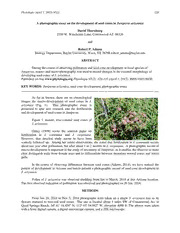
A photographic essay on the development of seed cones in Juniperus arizonica PDF
Preview A photographic essay on the development of seed cones in Juniperus arizonica
Phytologia (April 1, 2015) 97(2) 129 A photographic essay on the development of seed cones in Juniperus arizonica David Thornburg 2200 W. Winchester Lane, Cottonwood AZ 86326 and Robert P. Adams TX Biology Department, Baylor University, Waco, 76798 [email protected] ABSTRACT During the course of observing pollination and seed cone development in local species of Juniperus macro- and micro-photography was used to record changes in the external morphology of , developing seed cones of J. arizonica. Published on-line www.phytologia.org Phytologia 97(2): 129-131 (April 1, 2015). ISSN 030319430. KEY WORDS: Juniperus arizonica seed cone development, photographic essay. , As far as known, there are no chronological images the macro-development of seed cones in J. arizonica (Fig. 1). This photographic essay is presented to spur new research into the fertilization and development of seed cones in Juniperus. Figure 1. mature, rose-colored seed cones of J. arizonica. Ottley (1909) wrote the seminal paper on fertilization in J. communis and J. virginiana. However, that detailed study seems to have been scarcely followed up. Among her astute observations, she noted that fertilization in J. communis occurs A about one year after pollination, but after about 1 to 2 months in J. virginiana. photographic record of macro-development is important in the study of taxonomy ofJuniperus, as it enables the observer to more clear distinguish male from female trees and to differentiate between immature normal cones and insect galls. In the course of observing differences between seed cones (Adams, 2014), we have noticed the pattern of development in Arizona and herein present a photographic record of seed cone development in J. arizonica. Pollen of J. arizonica was observed shedding from Jan to March, 2014 at this Arizona location. The first observed indication of pollination was observed and photographed on 20 Jan. 2014. METHODS From Jan 20, 2014 to Nov 5, 2014 photographs were taken on a single J. arizonica tree as its SW flowers matured to rose-red seed cones. The site is located about 3 miles of Cottonwood, Az, at Quail Springs Ranch, 34° 4F 16.458" N, 112° 03' 04.982" W, elevation 4090 The photos were taken ft. with a Sony digital camera, a digital microscope camera, and a 20X microscope. 130 Phytologia (April 1, 2015) 97(2) RESULTS AND DISSCUSSION The following photos (Fig. 2) document changes in size, shape and color of the developing seed cones. It is interesting that changes in color occur very quickly after the release of pollen in the area, implying fertilization is not long-delayed. Because Ottley (1909) reported that fertilization varied between 1-2 months (J. virginiana) to 1 year (J. communis), it is difficult to ascertain when fertilization is occurring in J. arizonica. It could be as long as a year after pollination, but because J. arizonica is phylogenetically closer to J. virginiana than J. communis (Adams, 2014), it may be that the time is also short (1-2 months) as in J. virginiana. In addition, Fechner (1976) argues that the shorter time from pollination fertilization in J. virginiana is correlated with the maturity of seeds in one year, versus 3 years for J. communis (with a time of one year between pollination and fertilization). Because the seed cones of J. arizonica mature in one year, their time from pollination to fertilization is likely short. The development of seed cones may not be a sign of successful pollination. Fechner (1976) noted that in J. virginiana and J. scopulorum no differences were found in the size of filled and empty seeds. The deposition of pollen onto the stigma appears to trigger a mechanism which starts ovular development. Doroshenko (1928) theorized that the function of pollen in ovules is physical and that development could take place without fertilization. Fechner (1976) found that the germination of wind- pollinated seeds was lower than controlled-pollinated seeds from the same mother trees. He speculated this might be due to the presence of foreign pollen (eg. from another, nearby juniper species, such as cultivated J. chinensis and J. sabina). The alien juniper pollen could bring about seed development without a viable embryo. Recently, Adams, Thornburg and Corbet (2014) surveyed several Juniperus species for the incidence of empty vs filled seed cones. They reported J. arizonica Cottonwood, AZ, had , 34.4% (2010) and 33.4% (2011) filled cones. Juniperus osteosperma from nearby Sedona, AZ, had 79.0% (2010) and 7.2% (2011). They did not consider the fact that their J. arizonica population was nearly 100% J. arizonica whereas the J. osteosperma, near Sedona, was growing near four other native , juniper species, plus cultivated junipers nearby. The low incidence of filled seeds in 2011 (7.2%, J. osteosperma) might have been influenced by adjacent juniper pollen. In any case, it should be noted that our photos may well record seed cones with both filled and empty seeds. LITERATURE CITED Adams, R. P. 2014. The Junipers of the World: The genus Juniperus. Trafford Publ., Bloomington, IN. Adams, R. P. D. Thornburg and M. Corbet. 2014. The incidence of filled and empty seeds in Juniperus , of the western United States. Phytologia 96: 47-57. Fechner, G. H. 1976. Controlled pollination in eastern redcedar and Rocky Mountain junipers. Proc. 12th Lake States Forest Tree Improvement Conf. USFS Gen. Tech. Rep. NC-26. 24-34. Ottley, Alice. 1909. The development of the gametophytes and fertilization in Juniperus communis and Juniperus virginiana. Bot. Gaz. 48: 31-46. Phytologia (April 1, 2015) 97(2) 131 Figure 2. Photos of the development of seed cones of J .arizonica from 20 Jan. - 5 Nov. 2014.
